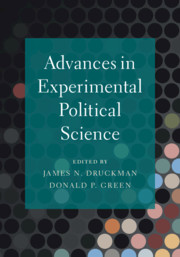Book contents
- Frontmatter
- Contents
- List of Figures
- List of Tables
- List of Boxes
- List of Contributors
- Acknowledgements
- 1 A New Era of Experimental Political Science
- Part I Experimental Designs
- 2 Conjoint Survey Experiments
- 3 Audit Studies in Political Science
- 4 Field Experiments with Survey Outcomes
- 5 How to Tame Lab-in-the-Field Experiments
- 6 Natural Experiments
- 7 Virtual Consent: The Bronze Standard for Experimental Ethics
- Part II Experimental Data
- Part III Experimental Treatments and Measures
- Part IV Experimental Analys is and Presentation
- Part V Experimental Reliability and Generalizability
- Part VI Using Experiments to study Identity
- Part VII Using Experiments to Study Government Actions
- Author Index
- Subject Index
6 - Natural Experiments
from Part I - Experimental Designs
Published online by Cambridge University Press: 08 March 2021
- Frontmatter
- Contents
- List of Figures
- List of Tables
- List of Boxes
- List of Contributors
- Acknowledgements
- 1 A New Era of Experimental Political Science
- Part I Experimental Designs
- 2 Conjoint Survey Experiments
- 3 Audit Studies in Political Science
- 4 Field Experiments with Survey Outcomes
- 5 How to Tame Lab-in-the-Field Experiments
- 6 Natural Experiments
- 7 Virtual Consent: The Bronze Standard for Experimental Ethics
- Part II Experimental Data
- Part III Experimental Treatments and Measures
- Part IV Experimental Analys is and Presentation
- Part V Experimental Reliability and Generalizability
- Part VI Using Experiments to study Identity
- Part VII Using Experiments to Study Government Actions
- Author Index
- Subject Index
Summary
The term natural experiment is used inconsistently. In one interpretation, it refers to an experiment where a treatment is randomly assigned by someone other than the researcher. In another interpretation, it refers to a study in which there is no controlled random assignment, but treatment is assigned by some external factor in a way that loosely resembles a randomized experiment–often described as an "as if random" assignment. In yet another interpretation, it refers to any non-randomized study that compares a treatment to a control group, without any specic requirements on how the treatment is assigned. I introduce an alternative definition that seeks to clarify the integral features of natural experiments and at the same time distinguish them from randomized controlled experiments. I define a natural experiment as a research study where the treatment assignment mechanism (i) is neither designed nor implemented by the researcher, (ii) is unknown to the researcher, and (iii) is probabilistic by virtue of depending on an external factor. The main message of this definition is that the difference between a randomized controlled experiment and a natural experiment is not a matter of degree, but of essence, and thus conceptualizing a natural experiment as a research design akin to a randomized experiment is neither rigorous nor a useful guide to empirical analysis. Using my alternative definition, I discuss how a natural experiment differs from a traditional observational study, and other practical recommendations for researchers who wish to use natural experiments to study causal effects.
Keywords
- Type
- Chapter
- Information
- Advances in Experimental Political Science , pp. 103 - 129Publisher: Cambridge University PressPrint publication year: 2021
- 18
- Cited by



